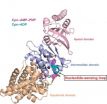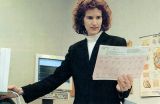A million chances to save a life
Penn Medicine crowdsourcing contest maps lifesaving AEDs in Philadelphia
2012-02-27
(Press-News.org) PHILADELPHIA -- Would you be able to find an automated external defibrillator if someone's life depended on it? Despite an estimated one million AEDs scattered around the United States, the answer, all too often when people suffer sudden cardiac arrests, is no.
In a Perspective piece published online this week in the journal Circulation: Cardiovascular Quality Outcomes, two researchers from the Perelman School of Medicine at the University of Pennsylvania outline the tremendous potential associated with greater utilization of AEDs in public places and a method to find the devices and help more people use them during emergencies.
In cases of ventricular fibrillation – a wild, disorganized cardiac rhythm that leaves the heart unable to properly pump blood through the body, which is the leading cause of sudden cardiac death – quick use of an AED and CPR improve a patient's chance of surviving by more than 50 percent. But since AEDs are sold through wholesalers, manufacturers have no way to track who buys them and where they're ultimately placed. That leaves two problems: No reliable way to connect bystanders with AEDs during emergencies, and no way to locate the devices during recalls or for regular servicing and inspection, like the process used to keep fire extinguishers in working order. Without a map of the devices, the more than 300,000 people who suffer cardiac arrest remain in great peril. Nationwide, just over 6 percent of these patients survive.
Raina Merchant, MD, MS, an assistant professor of Emergency Medicine and a senior fellow in the Leonard Davis Institute of Health Economics, and co-author, David Asch, MD, MBA, executive director of Penn's Leonard Davis Institute of Health Economics, envision a much brighter scenario. The Penn doctors envision a massive search for the location of these one million lifesaving AEDs and the creation of an Internet and mobile app-based map to pair the devices with people willing to use them during cardiac arrests. In addition to making the map available via smart phone for bystanders, they also call for providing this information to local 911 dispatchers. Rather than waiting for paramedics to arrive on the scene, a person calling for help after witnessing a cardiac arrest might then hear the following:
"Emergency Medical personnel are on their way. Continue chest compressions. There is an AED in the nearby bookstore, just at the checkout register. If available, send someone who is not performing chest compressions to retrieve the AED."
Penn Medicine's MyHeartMap Challenge, now in its third week, is taking a big step toward fulfilling that vision, by calling on Philadelphians to locate and help map all of the city's AEDs. The 298 teams participating in the contest so far – who stand to win $10,000 if they're the person or group to locate the largest number of the devices – are searching for AEDs in public places and snapping pictures of them on a special app for iPhones and Androids. Their submitted photos, tagged with location information will be used to create the type of interactive map Merchant suggests in her paper. Building on recent successes in utilizing crowdsourcing to solve science quandaries, and with a nod toward the public's increasing reliance on smart phones to provide them with everything from reviews of nearby restaurants to the location of gas stations when their car is running on fumes, the Penn team hopes to tap into the ingenuity and power of today's ultra-networked society to provide the data needed to put some real power behind the nation's AEDs.
The fruits of the six-week contest – especially if it can be replicated in other cities across the country – could lead not only to more immediate chances to save lives by putting defibrillators in the right hands at the right time, but also to new avenues for the study of best practices in resuscitation. Among questions a national AED database could help researchers answer: Was the device brought out for a real cardiac arrest? Did the device function properly? What prompted bystanders to play a role in caring for the patient? In the big picture, the Penn researchers hope that increased access to information on AED locations will buoy the nation's perennially dismal cardiac arrest survival rates.
INFORMATION:
For more information about the MyHeartMap Challenge, visit www.myheartmap.org, or on Twitter at @myheartmap.
About Penn Medicine
Penn Medicine is one of the world's leading academic medical centers, dedicated to the related missions of medical education, biomedical research, and excellence in patient care. Penn Medicine consists of the Raymond and Ruth Perelman School of Medicine at the University of Pennsylvania (founded in 1765 as the nation's first medical school) and the University of Pennsylvania Health System, which together form a $4 billion enterprise.
Penn's Perelman School of Medicine is currently ranked #2 in U.S. News & World Report's survey of research-oriented medical schools and among the top 10 schools for primary care. The School is consistently among the nation's top recipients of funding from the National Institutes of Health, with $507.6 million awarded in the 2010 fiscal year.
The University of Pennsylvania Health System's patient care facilities include: The Hospital of the University of Pennsylvania -- recognized as one of the nation's top 10 hospitals by U.S. News & World Report; Penn Presbyterian Medical Center; and Pennsylvania Hospital – the nation's first hospital, founded in 1751. Penn Medicine also includes additional patient care facilities and services throughout the Philadelphia region.
Penn Medicine is committed to improving lives and health through a variety of community-based programs and activities. In fiscal year 2010, Penn Medicine provided $788 million to benefit our community.
END
ELSE PRESS RELEASES FROM THIS DATE:
2012-02-27
LOS ALAMOS, New Mexico, February 24, 2012—A multinational team of scientists has developed a process for creating glass-based, inorganic light-emitting diodes (LEDs) that produce light in the ultraviolet range. The work, reported this week in the online Nature Communications, is a step toward biomedical devices with active components made from nanostructured systems.
LEDs based on solution-processed inorganic nanocrystals have promise for use in environmental and biomedical diagnostics, because they are cheap to produce, robust, and chemically stable. But ...
2012-02-27
CLEMSON — A study of X-rays emitted a long time ago in a galaxy far, far away has unmasked a stellar mass black hole in Andromeda, a spiral galaxy about 2.6 million light-years from Earth.
Two Clemson University researchers joined an an international team of astronomers, including scientists at Germany's Max Planck Institute for Extraterrestrial Physics, in publishing their findings in a pair of scientific journals this week.
Scientists had suspected the black hole was possible since late 2009 when an X-ray satellite observatory operated by the Max Planck Institute ...
2012-02-27
NEW YORK – February 24, 2012 – A forthcoming article in the Journal of Consumer Research by Professor Michel Tuan Pham, Kravis Professor of Business, Marketing, Columbia Business School; Leonard Lee, Associate Professor, Marketing, Columbia Business School; and Andrew Stephen, PhD '09, currently Assistant Professor of Business Administration, Joseph M. Katz Graduate School of Business, University of Pittsburgh, finds that a higher trust in feelings may result in more accurate predictions about a variety of future events. The research will also be featured in Columbia Business ...
2012-02-27
The gold standard for nanotechnology is nature's own proteins. These biomolecular nanomachines – macromolecules forged from peptide chains of amino acids - are able to fold themselves into a dazzling multitude of shapes and forms that enable them to carry out an equally dazzling multitude of functions fundamental to life. As important as protein folding is to virtually all biological systems, the mechanisms behind this process have remained a mystery. The fog, however, is being lifted.
A team of researchers with the U.S. Department of Energy (DOE)'s Lawrence Berkeley ...
2012-02-27
Patients with heart disease who took cholesterol-lowering statins were significantly less likely to develop depression than those who did not, in a study by Mary Whooley, MD, a physician at the San Francisco VA Medical Center and a professor of medicine at the University of California, San Francisco.
The study was published electronically in the Journal of Clinical Psychiatry (February 21, 2012).
Whooley and her research team evaluated 965 heart disease patients for depression, and found that the patients who were on statins were significantly less likely to be clinically ...
2012-02-27
NEW YORK – February 24, 2012 – A recent study in the Review of Financial Studies proposes a new, valuation-based measure of equity market segmentation. Equity market segmentation occurs when stocks of similar risk in different countries are priced differently. The study, by Columbia Business School Professor Geert Bekaert, Chazen Senior Scholar at The Jerome A. Chazen Institute of International Business at Columbia Business School and the Leon G. Cooperman Professor of Finance and Economics, uncovers the factors that cause variation in market segmentation, both through ...
2012-02-27
Prehistoric Eurasian nomads are commonly perceived as horse riding bandits who utilized their mobility and military skill to antagonize ancient civilizations such as the Chinese, Persians, and Greeks. Although some historical accounts may support this view, a new article by Dr. Michael Frachetti (Washington University, St. Louis) illustrates a considerably different image of prehistoric pastoralist societies and their impact on world civilizations more than 5000 years ago.
In the article, recently published in the February issue of Current Anthropology, Frachetti argues ...
2012-02-27
Boulder, Colorado, USA - Linear dunes, widespread on Earth and Saturn's moon, Titan, are generally considered to have been formed by deposits of windblown sand. It has been speculated for some time that some linear dunes may have formed by "wind-rift" erosion, but this model has commonly been rejected due to lack of sufficient evidence. Now, new research supported by China's NSF and published this week in GSA BULLETIN indicates that erosional origin models should not be ruled out.
The linear dunes in China's Qaidam Basin have been proposed to have formed as self-extending ...
2012-02-27
Boulder, CO, USA - New GSA BULLETIN science published online 24 Feb. includes work on the Chugach Metamorphic Complex of southern Alaska; news and data from the first non-Russian science team to make a helicopter over-flight of Shiveluch volcano in Kamchatka, Russia, after its large 2005 eruption; and a study by a team from the Lamont-Doherty Earth Observatory that proposes a new calibration model for the Eocene segment of the Geomagnetic Polarity Time Scale (GPTS).
Large-scale, short-lived metamorphism, deformation, and magmatism in the Chugach metamorphic complex, ...
2012-02-27
A UCLA-led group of researchers tracing disparities in life expectancy between blacks and whites in the U.S. has found that white males live about seven years longer on average than African American men and that white women live more than five years longer than their black counterparts.
But when comparing life expectancy on a state-by-state basis, the researchers made a surprising discovery: In those states in which the disparities were smallest, the differences often were not the result of African Americans living longer but of whites dying younger than the national ...
LAST 30 PRESS RELEASES:
[Press-News.org] A million chances to save a life
Penn Medicine crowdsourcing contest maps lifesaving AEDs in Philadelphia



